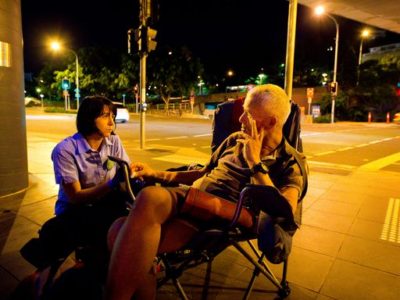Boulder County, Colorado, has achieved quality data for veteran homelessness.
This means they know every veteran experiencing homelessness by name, as well as their homeless history and housing needs, in near real time. With this detailed information, homeless organizations throughout Boulder County are better able to match housing solutions with the needs of the individuals. Information is collected and shared with consent, and data is updated at least monthly.
“To achieve quality data for veterans means that we know who’s in our community,” said Heidi Grove, who is the Homeless Solutions for Boulder County Systems Manager. “We identify our veterans person-by-person, and strategize the most appropriate exit and resources for them to end homelessness.”
Using this data, Boulder County is also able to track toward functional zero, a state where veteran homelessness is measurably rare and brief.
Boulder County is part of Metro Denver’s subregional approach to homelessness. Metro Denver has a large seven-county geography with a total population of 3.2 million across 40 municipalities. As part of Built for Zero, the community is working together to reach functional zero for veteran homelessness across this entire metro area.
“We know experiences of homelessness are not just [occurring] in a single geographic area — it’s transient,” Grove said. “To be able to reach across the county and city municipal lines to really work together to solve homelessness one person at a time is critical.”
Boulder County is the first of nine subregions in Metro Denver that has reached quality data for veterans.
Getting to quality data for veterans experiencing homelessness
Quality data enables Boulder County to meet the needs of veterans who are unhoused by supporting them with the services or resources they need to exit homelessness. These services often include housing coordination through vouchers and placements. Quality data shows inflow and outflow, while maintaining that all community members experiencing homelessness are recorded in a timely and accurate manner.
This person-specific data powers a practice known as case conferencing in Boulder County, where service providers, such as Veterans Community Project, Boulder County Community Services, Boulder County Veteran Service Officers, and the Continuum of Care meet to resolve cases of homelessness. During these meetings, they go through their list of veterans experiencing homelessness and problem solve for each person. The data helps align resources in order to match housing solutions with the needs of individuals.
At the population level, quality data enables communities to be able to track the changing size, composition, and dynamics of their homeless population. This information supports prioritizing resources, testing changes to their system, and understanding whether their efforts are helping to drive those numbers down toward zero.

“To achieve quality data for veterans means that we know who’s in our community. We identify our veterans person-by-person, and strategize the most appropriate exit and resources for them to end homelessness.”
-Heidi Grove
There were challenges to reaching quality data in Boulder County. The local team had to create a data-sharing policy in order to organize veterans’ information across different systems. The local Continuum of Care operated on a Homelessness Management Information System (HMIS), whereas the County relied on a database called Boulder County Connect (BCC). Veterans that were registered with one system sometimes did not appear in another. Service providers found it hard to recognize veterans by their names.
After data-sharing procedures were put in place, Grove noted a vast difference in better systems. The other challenge was that areas in the County cross two different Continuums of Care.
“A major piece of getting to quality data was just being able to share information between the two data systems and across the Continuums of Care,” she said. Now, veterans can be served either through the Continuum of Care they choose, or through the County. And, if a veteran chooses to not be registered with either system, they still have opportunities to receive support as Veterans Community Project works with all service veterans regardless of discharge status.
Working with Built for Zero on quality data helped Boulder County validate that its HMIS system was reliable and replicable, added Sofia Vigil, the Continuum of Care Improvement Advisor in Boulder. Vigil drove forth the effort of developing quality data by using the Built for Zero scorecard as a guide. The scorecard measures the regularity of community outreach, participation, and service delivery.
“I see that [data] translating really well into our other subregions and another way that we can advocate for them to lean on our system more and kind of show that it is working,” Vigil said.

Strengthening collaboration across the region
In August, all nine Metro Denver subregions convened for a learning session, where they celebrated Boulder’s achievement of reaching quality data on veterans. During this gathering, each subregion also shared their progress toward gathering quality, by-name data and set six-month goals.
By breaking the large Metro Denver region up into nine subregions, it makes the challenge of solving veteran homelessness across the area less daunting, said Zac Schaffner, a Supportive Housing Services Manager with the Colorado Department of Local Affairs.
“It breaks things down into those measurable chunks,” Schaffner said. “It was too large for the Denver metro community to try and take it on all at once. When we’re able to move it into those regions, folks could really see the problems that need to be solved. And what the tools are, what the resources are, and then really make those measurable reductions.”
As the remaining subregions of Metro Denver work to achieve quality data for veteran homelessness, Boulder County has demonstrated that “something of this magnitude is actually doable,” said Dr. Jamie Rife, the Executive Director of the Metro Denver Homeless Initiative.
Dr. Rife considers quality data as a step toward uniting different movements behind the aim of ending homelessness. “It’s politically agnostic,” she added, “which is something I have found is that everyone, no matter your side of the aisle, can get behind quality data and be more efficient and effective in understanding the issue.”
“Quality data, simply put, is a game changer for communities.”
Melanie Lewis Dickerson
Developing quality, by-name lists across the entirety of Metro Denver will better enable local, state, and federal resources to work together and support homelessness reduction across the region. Ian Fletcher, a Strategy Lead of Regional Large-Scale Change in Built for Zero, has seen a great increase in buy-in on quality data from local stakeholders.
“This has included electeds, new providers, and local leaders outside of our traditional partners towards ending veteran homelessness,” Fletcher said.
“Quality data, simply put, is a game changer for communities. It allows them to have line of sight into a very complex problem to understand the needs of folks experiencing homelessness in their community,” added Melanie Lewis Dickerson, a Portfolio Lead at Built for Zero.
Boulder County hopes to achieve functional zero for veterans in their subregion by January 31, 2023, before focusing on other subpopulations, such as youth, families, or people experiencing chronic homelessness.
“No matter what you’re doing, no matter where you are, you have to have quality data in order to be able to make any decisions,” Dr. Rife concluded. “And I think that’s something we can all agree on, no matter what type of homelessness you are looking to address.”





